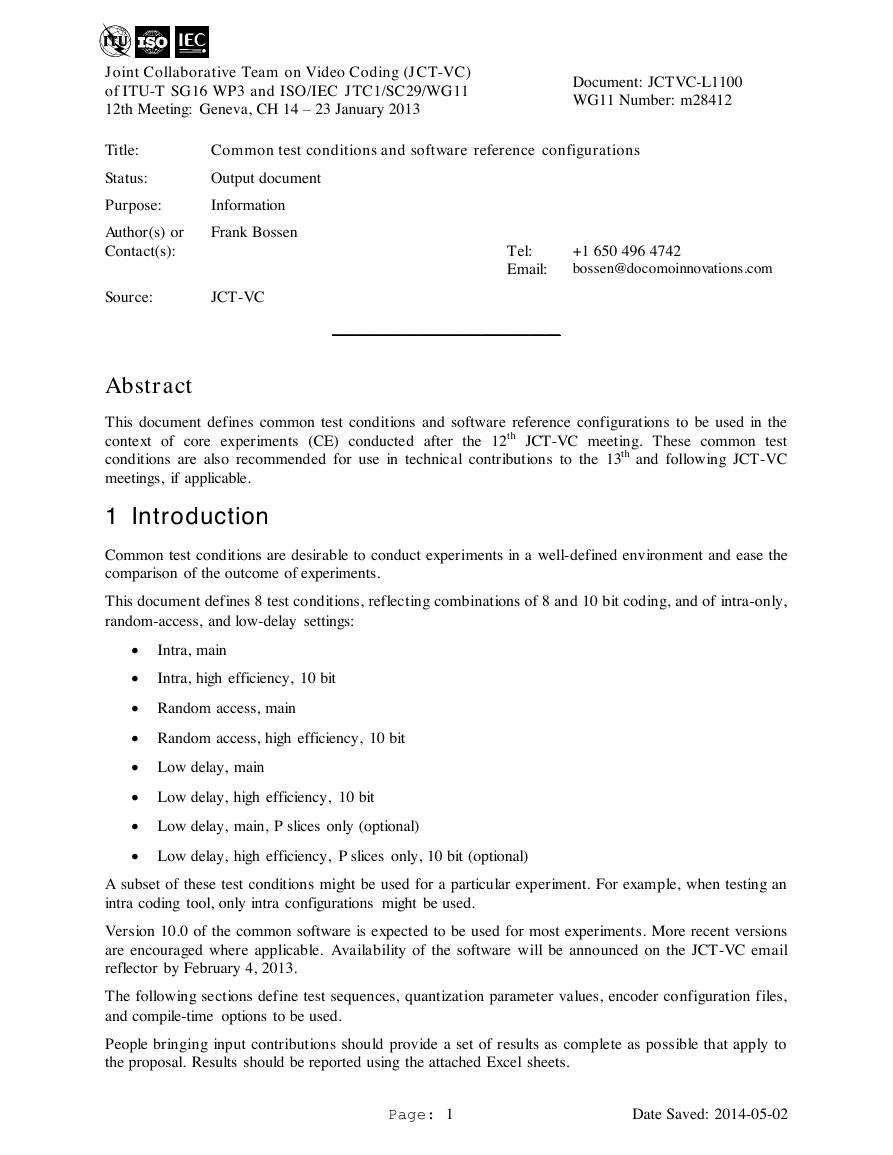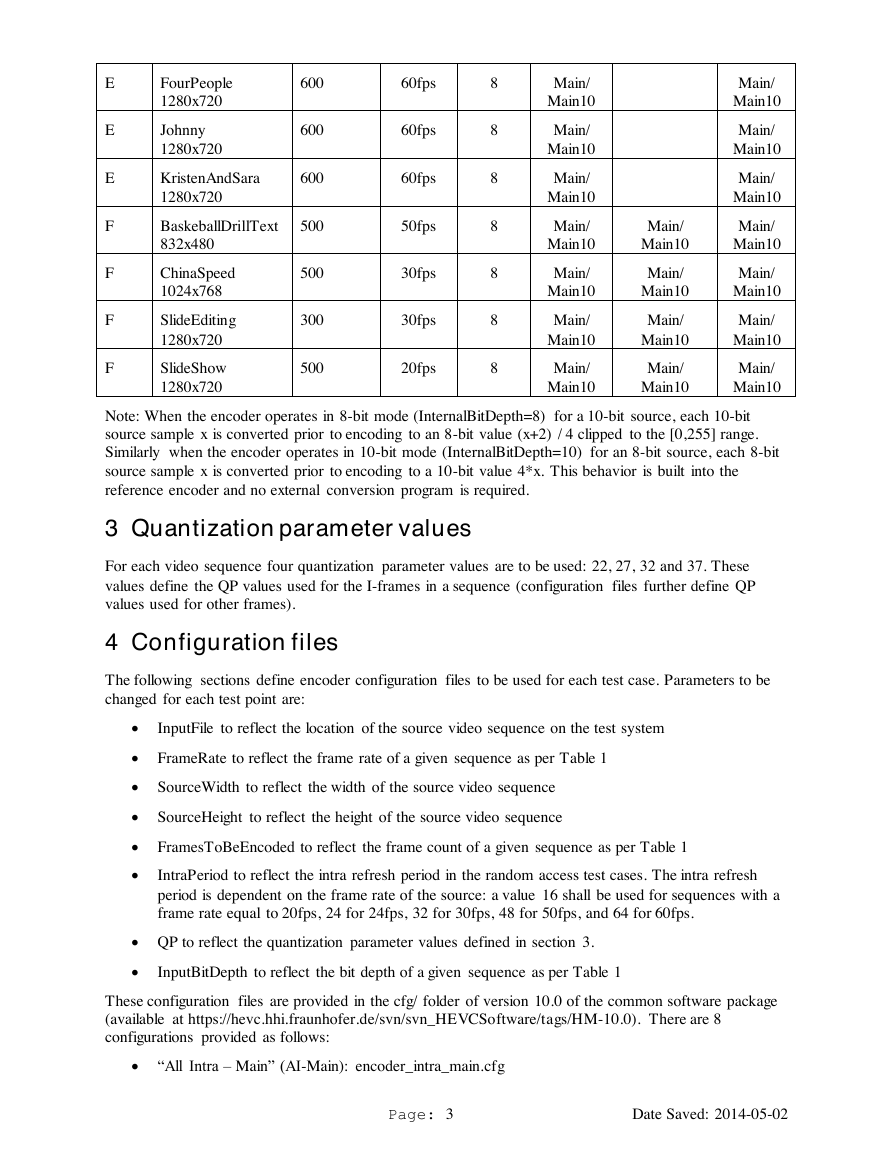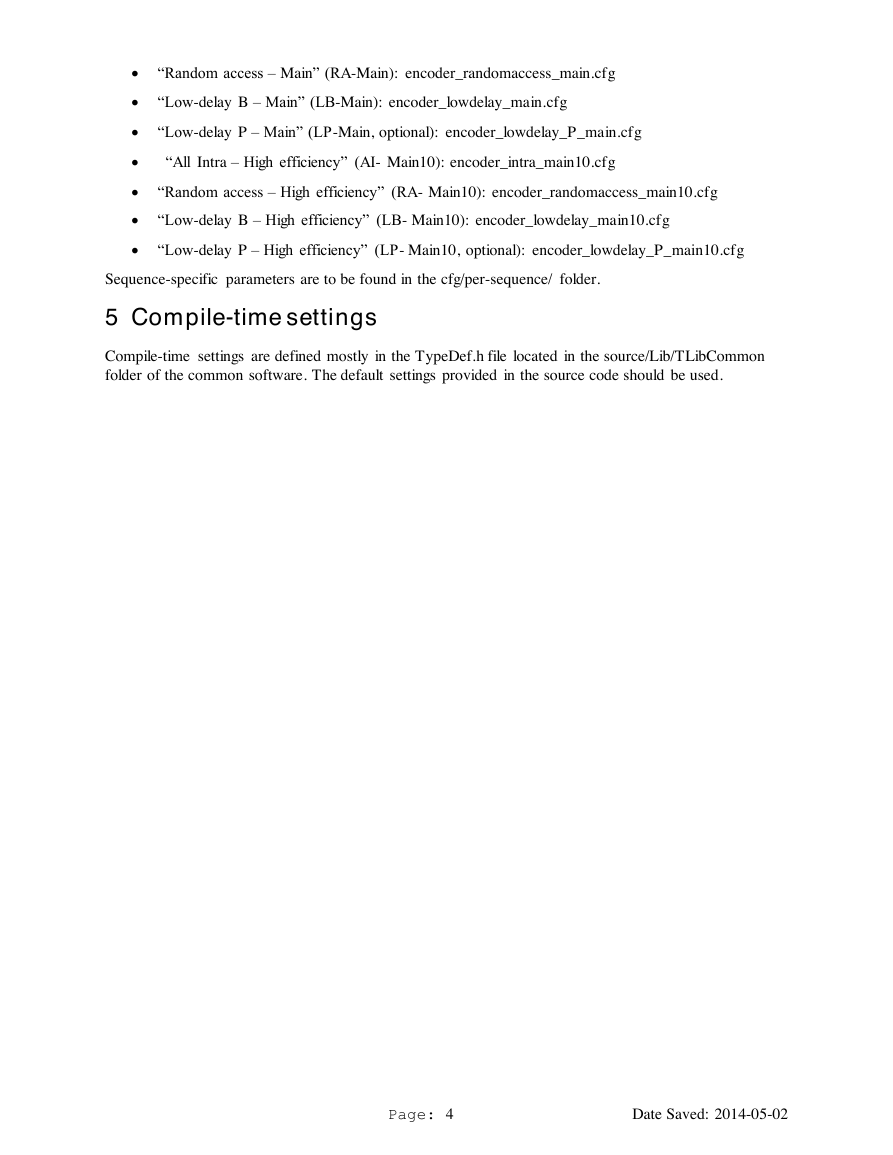Joint Collaborative Team on Video Coding (JCT-VC)
of ITU-T SG16 WP3 and ISO/IEC JTC1/SC29/WG11
12th Meeting: Geneva, CH 14 – 23 January 2013
Document: JCTVC-L1100
WG11 Number: m28412
Title:
Status:
Common test conditions and software reference configurations
Output document
Purpose:
Information
Author(s) or
Contact(s):
Frank Bossen
Source:
JCT-VC
Abstract
Tel:
Email:
+1 650 496 4742
bossen@docomoinnovations.com
_____________________________
This document defines common test conditions and software reference configurations to be used in the
context of core experiments (CE) conducted after the 12th JCT-VC meeting. These common test
conditions are also recommended for use in technical contributions to the 13th and following JCT-VC
meetings, if applicable.
1 Introduction
Common test conditions are desirable to conduct experiments in a well-defined environment and ease the
comparison of the outcome of experiments.
This document defines 8 test conditions, reflecting combinations of 8 and 10 bit coding, and of intra-only,
random-access, and low-delay settings:
Intra, main
Intra, high efficiency, 10 bit
Random access, main
Random access, high efficiency, 10 bit
Low delay, main
Low delay, high efficiency, 10 bit
Low delay, main, P slices only (optional)
Low delay, high efficiency, P slices only, 10 bit (optional)
A subset of these test conditions might be used for a particular experiment. For example, when testing an
intra coding tool, only intra configurations might be used.
Version 10.0 of the common software is expected to be used for most experiments. More recent versions
are encouraged where applicable. Availability of the software will be announced on the JCT-VC email
reflector by February 4, 2013.
The following sections define test sequences, quantization parameter values, encoder configuration files,
and compile-time options to be used.
People bringing input contributions should provide a set of results as complete as possible that apply to
the proposal. Results should be reported using the attached Excel sheets.
Page: 1
Date Saved: 2014-05-02
�
2 Test sequences
Table 1 defines the set of test sequences to be used for intra, random-access, and low-delay conditions.
All frames (as defined by frame count in the table) shall be encoded for all sequences and test cases
described below (see Section 4 for definitions of Main and Main10).
Test sequences are available on ftp://hevc@ftp.tnt.uni-hannover.de/testsequences/ (please contact the
JCT-VC chairs for login information).
Table 1 Test sequences
Class
Sequence name
Resolution
Traffic
2560x1600
PeopleOnStreet
2560x1600
Nebuta
2560x1600
SteamLocomotive
2560x1600
Kimono
1920x1080
ParkScene
1920x1080
Cactus
1920x1080
BQTerrace
1920x1080
BasketballDrive
1920x1080
RaceHorses
832x480
BQMall
832x480
PartyScene
832x480
BasketballDrill
832x480
RaceHorses
416x240
BQSquare
416x240
BlowingBubbles
416x240
BasketballPass
416x240
A
A
A
A
B
B
B
B
B
C
C
C
C
D
D
D
D
Frame
count
150
150
300
300
240
240
500
600
500
300
600
500
500
300
600
500
500
Frame
rate
Bit
depth
Intra
Random
access
Low-
delay
30fps
30fps
60fps
60fps
24fps
24fps
50fps
60fps
50fps
30fps
60fps
50fps
50fps
30fps
60fps
50fps
50fps
8
8
10
10
8
8
8
8
8
8
8
8
8
8
8
8
8
Main/
Main10
Main/
Main10
Main/
Main10
Main/
Main10
Main/
Main10
Main/
Main10
Main/
Main10
Main/
Main10
Main/
Main10
Main/
Main10
Main/
Main10
Main/
Main10
Main/
Main10
Main/
Main10
Main/
Main10
Main/
Main10
Main/
Main10
Main/
Main10
Main/
Main10
Main/
Main10
Main/
Main10
Main/
Main10
Main/
Main10
Main/
Main10
Main/
Main10
Main/
Main10
Main/
Main10
Main/
Main10
Main/
Main10
Main/
Main10
Main/
Main10
Main/
Main10
Main/
Main10
Main/
Main10
Main/
Main10
Main/
Main10
Main/
Main10
Main/
Main10
Main/
Main10
Main/
Main10
Main/
Main10
Main/
Main10
Main/
Main10
Main/
Main10
Main/
Main10
Main/
Main10
Main/
Main10
Page: 2
Date Saved: 2014-05-02
�
E
E
E
F
F
F
F
FourPeople
1280x720
Johnny
1280x720
KristenAndSara
1280x720
BaskeballDrillText
832x480
ChinaSpeed
1024x768
SlideEditing
1280x720
SlideShow
1280x720
600
600
600
500
500
300
500
60fps
60fps
60fps
50fps
30fps
30fps
20fps
8
8
8
8
8
8
8
Main/
Main10
Main/
Main10
Main/
Main10
Main/
Main10
Main/
Main10
Main/
Main10
Main/
Main10
Main/
Main10
Main/
Main10
Main/
Main10
Main/
Main10
Main/
Main10
Main/
Main10
Main/
Main10
Main/
Main10
Main/
Main10
Main/
Main10
Main/
Main10
Note: When the encoder operates in 8-bit mode (InternalBitDepth=8) for a 10-bit source, each 10-bit
source sample x is converted prior to encoding to an 8-bit value (x+2) / 4 clipped to the [0,255] range.
Similarly when the encoder operates in 10-bit mode (InternalBitDepth=10) for an 8-bit source, each 8-bit
source sample x is converted prior to encoding to a 10-bit value 4*x. This behavior is built into the
reference encoder and no external conversion program is required.
3 Quantization parameter values
For each video sequence four quantization parameter values are to be used: 22, 27, 32 and 37. These
values define the QP values used for the I-frames in a sequence (configuration files further define QP
values used for other frames).
4 Configuration files
The following sections define encoder configuration files to be used for each test case. Parameters to be
changed for each test point are:
InputFile to reflect the location of the source video sequence on the test system
FrameRate to reflect the frame rate of a given sequence as per Table 1
SourceWidth to reflect the width of the source video sequence
SourceHeight to reflect the height of the source video sequence
FramesToBeEncoded to reflect the frame count of a given sequence as per Table 1
IntraPeriod to reflect the intra refresh period in the random access test cases. The intra refresh
period is dependent on the frame rate of the source: a value 16 shall be used for sequences with a
frame rate equal to 20fps, 24 for 24fps, 32 for 30fps, 48 for 50fps, and 64 for 60fps.
QP to reflect the quantization parameter values defined in section 3.
InputBitDepth to reflect the bit depth of a given sequence as per Table 1
These configuration files are provided in the cfg/ folder of version 10.0 of the common software package
(available at https://hevc.hhi.fraunhofer.de/svn/svn_HEVCSoftware/tags/HM-10.0). There are 8
configurations provided as follows:
“All Intra – Main” (AI-Main): encoder_intra_main.cfg
Page: 3
Date Saved: 2014-05-02
�
“Random access – Main” (RA-Main): encoder_randomaccess_main.cfg
“Low-delay B – Main” (LB-Main): encoder_lowdelay_main.cfg
“Low-delay P – Main” (LP-Main, optional): encoder_lowdelay_P_main.cfg
“All Intra – High efficiency” (AI- Main10): encoder_intra_main10.cfg
“Random access – High efficiency” (RA- Main10): encoder_randomaccess_main10.cfg
“Low-delay B – High efficiency” (LB- Main10): encoder_lowdelay_main10.cfg
“Low-delay P – High efficiency” (LP- Main10, optional): encoder_lowdelay_P_main10.cfg
Sequence-specific parameters are to be found in the cfg/per-sequence/ folder.
5 Compile-time settings
Compile-time settings are defined mostly in the TypeDef.h file located in the source/Lib/TLibCommon
folder of the common software. The default settings provided in the source code should be used.
Page: 4
Date Saved: 2014-05-02
�








 2023年江西萍乡中考道德与法治真题及答案.doc
2023年江西萍乡中考道德与法治真题及答案.doc 2012年重庆南川中考生物真题及答案.doc
2012年重庆南川中考生物真题及答案.doc 2013年江西师范大学地理学综合及文艺理论基础考研真题.doc
2013年江西师范大学地理学综合及文艺理论基础考研真题.doc 2020年四川甘孜小升初语文真题及答案I卷.doc
2020年四川甘孜小升初语文真题及答案I卷.doc 2020年注册岩土工程师专业基础考试真题及答案.doc
2020年注册岩土工程师专业基础考试真题及答案.doc 2023-2024学年福建省厦门市九年级上学期数学月考试题及答案.doc
2023-2024学年福建省厦门市九年级上学期数学月考试题及答案.doc 2021-2022学年辽宁省沈阳市大东区九年级上学期语文期末试题及答案.doc
2021-2022学年辽宁省沈阳市大东区九年级上学期语文期末试题及答案.doc 2022-2023学年北京东城区初三第一学期物理期末试卷及答案.doc
2022-2023学年北京东城区初三第一学期物理期末试卷及答案.doc 2018上半年江西教师资格初中地理学科知识与教学能力真题及答案.doc
2018上半年江西教师资格初中地理学科知识与教学能力真题及答案.doc 2012年河北国家公务员申论考试真题及答案-省级.doc
2012年河北国家公务员申论考试真题及答案-省级.doc 2020-2021学年江苏省扬州市江都区邵樊片九年级上学期数学第一次质量检测试题及答案.doc
2020-2021学年江苏省扬州市江都区邵樊片九年级上学期数学第一次质量检测试题及答案.doc 2022下半年黑龙江教师资格证中学综合素质真题及答案.doc
2022下半年黑龙江教师资格证中学综合素质真题及答案.doc